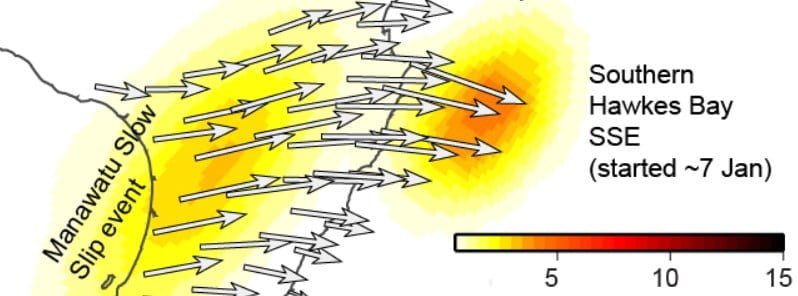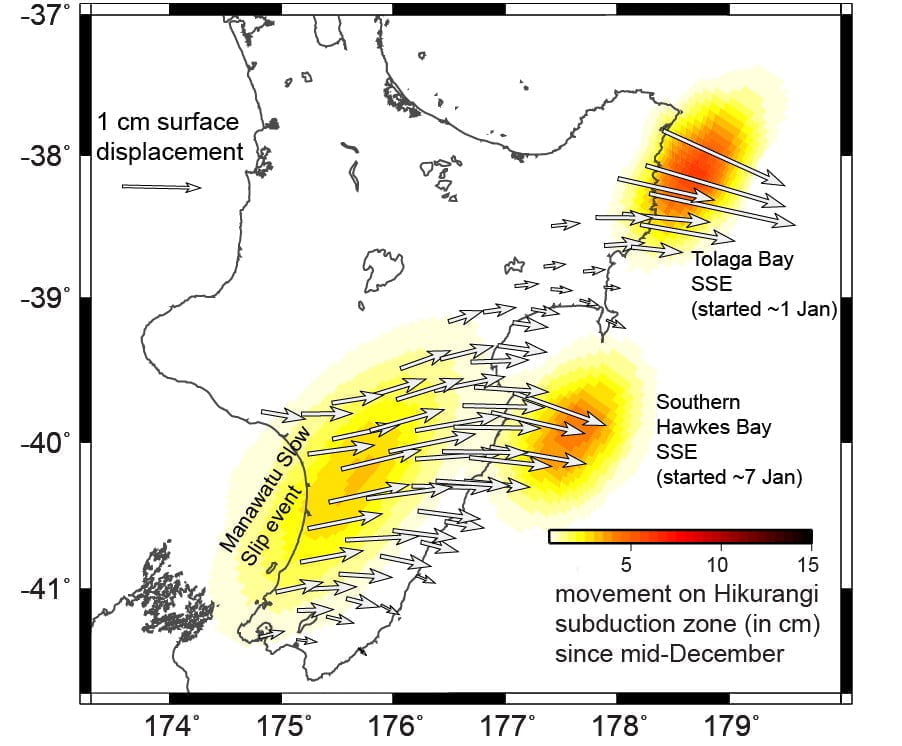Slow slip events underway on Hikurangi subduction zone in New Zealand, releasing energy equivalent to M7 earthquake

Another slow-motion earthquake, or “slow slip event,” is now underway on the Hikurangi subduction plate boundary offshore the North Island’s east coast. The amount of slow slip movement during the last month has released energy equivalent to a magnitude 7 earthquake.
- GeoNet’s sensors have detected slow slip earthquakes off the East Coast North Island and the Manawatu region over the past 30 days
- These slow slip events, also known as slow-motion earthquakes, unfold over weeks to months and cannot be felt by humans. However, they can be detected using GeoNet’s network of continuously operating GNSS stations that track millimeter-level changes in land movement on a daily basis
GNSS stations along the southern coast of the Hawkes Bay area and north of Gisborne have shifted eastward by 1 – 2 cm (4 – 8 inches) since the start of the year, GeoNet reported on January 20, 2023.1
These subtle land movements indicate that another slow-motion earthquake, or “slow slip event,” is now underway on the Hikurangi subduction plate boundary offshore the North Island’s east coast.
Scientists estimate that the amount of movement on the subduction zone during the current event is now up to 7 or 8 cm (2.7 – 3.1 inches) over the last couple of weeks.

These events come several months after a large slow slip event offshore Hawkes Bay in 2022, which occurred on a portion of the fault sandwiched between where the latest events are occurring.
In addition to the slow slip event, two small swarms of earthquakes have been observed in the region near Ruatōria and Tokomaru Bay, with magnitudes ranging from 1 to 3.5. These earthquakes are likely related to the slow slip event, as they occur due to changes in stress in the earth’s crust.
Another slow-motion earthquake beneath the Manawatu region started up early last year, which is expected as these events occur beneath the Manawatu approximately every five years.
GNSS stations in the North Island suggest that the Manawatu slow slip event has picked up more steam in the last month, with 3 – 4 cm (1.18 – 1.57 inches) of motion on the subduction plate boundary located at 30 – 40 km (18.6 – 24.8 miles) beneath the Manawatu region.
Overall, the amount of slow slip movement during the last month on the Hikurangi subduction zone has released energy equivalent to a magnitude 7 earthquake.
Scientists have recently deployed large, temporary networks of sensors to detect these slow slip events, and any related seismic activity. This latest sequence of slow slip events is well-timed for scientists to learn far more than they ever have about New Zealand’s slow-motion earthquakes.
“Slow-slip events are a great reminder that we live on a very active tectonic plate boundary here in New Zealand,” GNS Science Geophysicist Laura Wallace said.
If you feel an earthquake: Drop, Cover and Hold. If you are near the coast and you feel a Long OR Strong earthquake, get to higher ground or as far inland as possible once the shaking has stopped in case a tsunami was generated.
References:
1 Slow slip earthquakes kick into high gear for 2023 – Laura Wallace/GNS Science Geophysicist – January 20, 2023
Featured image credit: GeoNet

Commenting rules and guidelines
We value the thoughts and opinions of our readers and welcome healthy discussions on our website. In order to maintain a respectful and positive community, we ask that all commenters follow these rules:
We reserve the right to remove any comments that violate these rules. By commenting on our website, you agree to abide by these guidelines. Thank you for helping to create a positive and welcoming environment for all.